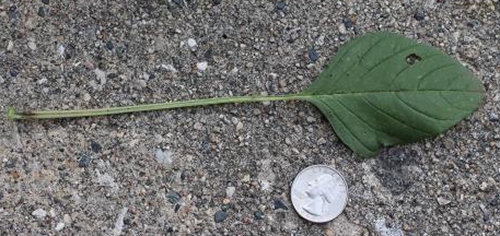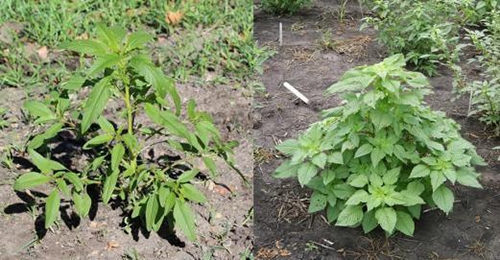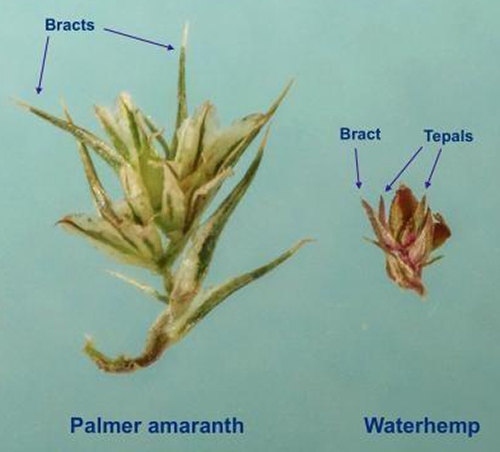You are here
Home ›Scout now for Palmer Amaranth

Figure 1 ... Palmer amaranth leaf with a petiole longer than the leaf blade. Folding the leaf over at the base is the fastest way to check for this trait. Submitted photo.

Figure 2 ... Waterhemp’s open canopy (left) compared to Palmer amaranth’s denser, leafy canopy (right). Submitted photo.

Figure 3 ... Comparison of a female Palmer amaranth flower and a female waterhemp flower. Submitted photo.

Figure 4 ... Female Palmer amaranth with long terminal inflorescences. Submitted photo.
by Meaghan Anderson, Field Agronomist and Dr. Bob Hartzler, Professor of Agronomy, Integrated Crop Management News and Iowa State University Extension and Outreach
Now is a great time to scout for Palmer amaranth (Amaranthus palmeri) in Iowa crop fields. As of late 2018, this species had been identified in over half of Iowa’s 99 counties. While new identifications have waned since the widespread introductions in 2016, Palmer amaranth is a species to watch out for in virtually any Iowa crop field. A native of the American southwest, Palmer amaranth is more competitive than common waterhemp (Amaranthus tuberculatus), a pigweed native to Iowa. Both species are known for fast development of herbicide resistance, prolific seed production (>500,000 seeds/plant possible), and prolonged emergence.
The addition of Palmer amaranth to Iowa’s noxious weed law as of July 1, 2017 highlights the importance of this weed to Iowans and its potential impact on Iowa agriculture. Early identification is key to eradicating this weed from Iowa fields. Eradication cannot happen without vigilance, early detection, and appropriate response soon after it invades an area. Palmer amaranth is reaching the growth stage where distinguishing it from waterhemp is easier due to the presence of flowers. In addition to fields where Palmer amaranth has been found previously, other priority areas to scout include farms that utilize feed and bedding from southern states, fields receiving manure from those farms, and farms where out-of-state equipment has been used.
Palmer amaranth and waterhemp lack pubescence (hair) on plant parts like stems, petioles, and leaves, while other common amaranth (pigweed) species have hair on stems and/or leaves. Early in the growing season, Palmer amaranth is difficult to differentiate from waterhemp due to the high variability in both species. Leaves on Palmer amaranth often have a petiole that is longer than the leaf blade, this is the most reliable vegetative trait to differentiate the two species (Figure 1). Leaves on Palmer amaranth are often clustered tightly at the top of the plant. People often observe Palmer amaranth as a denser-canopied weed as well (Figure 2).
Palmer amaranth leaf with petiole longer than leaf blade Figure 1. Palmer amaranth leaf with a petiole longer than the leaf blade. Folding the leaf over at the base is the fastest way to check for this trait.
Waterhemp’s open canopy compared to Palmer amaranth’s denser canopy Figure 2. Waterhemp’s open canopy (left) compared to Palmer amaranth’s denser, leafy canopy (right).
Once they flower, Palmer amaranth and waterhemp produce male and female flowers on separate plants. Identifying males from females should be relatively simple due to the small, black seed produced by female flowers or the presence of pollen on male plants. Female Palmer amaranth are easy to distinguish from waterhemp due to their long, sharp bracts (Figure 3) surrounding the flowers on tall terminal inflorescences (Figure 4). If you discover this weed, steps should be taken to remove all plants to prevent seed production.
Comparison of a female Palmer amaranth flower and a female waterhemp flower Figure 3. Comparison of a female Palmer amaranth flower and a female waterhemp flower. Female Palmer amaranth with long terminal inflorescences Figure 4. Female Palmer amaranth with long terminal inflorescences.
Continued vigilance is imperative to slow the speed with which Palmer amaranth invades our state. If you observe a plant that you think may be Palmer amaranth, please don’t hesitate to contact Bob Hartzler at 515-294-1164 or hartzler@iastate.edu or Meaghan Anderson at 319-331-0058 or mjanders@iastate.edu.

